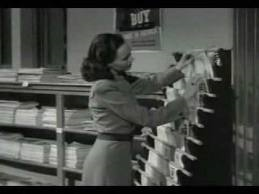Reed masterly uses different cinematographic techniques to make how the audience sees the film just as important as what they see. In the beginning of the film, Martin is looking for Harry’s apartment. When he is outside Harry’s building, Reed makes use of the full shot to illustrate how small and powerless Martin is in this new environment. As the film progresses, Reed uses full shots for other purposes such as juxtapositions between old and new Vienne as seen in the shot below.
Reed makes very good use of close ups as well. Most of the close-up shots of Martin occur when he is in tight areas or when he seems to be feeling trapped.
Not only is he trapped due to his lack of knowledge of how things work in this foreign land, he is also literally trapped within the frame of the camera. This really emphasizes how much of a predicament he finds himself especially once he learns the truth about Harry. Reed also ingeniously uses a close-up shot of Harry as he is dying on the steps after being shot.
At this point Harry has run out of places to hide not only from the police but from the camera as well. Unlike the scene where the audience catches their first glimpse of a living, breathing Harry hiding in the dark, out of sight from the camera, he is trapped by the camera and by death.
One of the most notable techniques that Reed uses in The Third Man is the Dutch angle. It seems as if there are more Dutch angles in the film than there are regular shots. Reed uses the Dutch angle to signify that something is abnormal about certain characters or situations. In the following shot of Harry, Reed uses a Dutch angle which signifies that Harry is a crooked character.
He is a criminal who does not care about how his actions affect other people as long as he can make a quick buck. Based on the company he keeps and the way he acts towards Martin, he may be homosexual. This is another reason why Reed uses a Dutch angle to portray Harry. He is not just off morally, but his sexual orientation is not straight hence the not straight angle used to portray him.







